 Wisconsin Lawyer
Wisconsin Lawyer
Vol. 85, No. 6, June 2012
The Law of Counterterrorism
Edited by Lynne K. Zusman (Chicago, IL: ABA Administrative Law & Regulatory Practice Section, 2011). 320 pgs. $99.95. Order, www.ababooks.org.
Reviewed by Christina M. Lucchesi
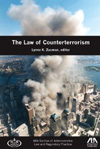 The U.S. Department of Defense defines counterterrorism as "operations that include the offensive measures taken to prevent, deter, preempt, and respond to terrorism." The Law of Counterterrorism provides an excellent analysis of this subject while tracing the origins and development of both national and international counterterrorism law. Detailed discussions are devoted to the USA PATRIOT Act, the Taliban and al-Qaeda, the U.S. Department of Justice (DOJ) torture memorandum, war crimes jurisdiction, the 9/11 Commission, detention, interrogation, and surveillance laws.
The U.S. Department of Defense defines counterterrorism as "operations that include the offensive measures taken to prevent, deter, preempt, and respond to terrorism." The Law of Counterterrorism provides an excellent analysis of this subject while tracing the origins and development of both national and international counterterrorism law. Detailed discussions are devoted to the USA PATRIOT Act, the Taliban and al-Qaeda, the U.S. Department of Justice (DOJ) torture memorandum, war crimes jurisdiction, the 9/11 Commission, detention, interrogation, and surveillance laws.
The book's contributors explore the legal authority for "a new type of war" and the manner in which counterterrorism law has sought to respond to an elusive and oftentimes shape-shifting threat. Against a detailed historical backdrop, W. Hays Parks, senior associate deputy general counsel with the Department of Defense, discusses whether members of the Taliban and al-Qaeda are entitled to combatant and prisoner-of-war status. New York City Police Commissioner Raymond W. Kelly examines the counterterrorism efforts of the city's police department in the wake of the attacks that occurred on Sept. 11, 2001, and the delicate balance between privacy rights and constitutional protections, on one hand, and defending against terrorism threats, on the other. Jeffrey Breinholt, attorney-advisor in the DOJ's Office of Law and Policy, National Security Division, discusses the developing criminal laws written to address the modern terrorism issue and, in particular, examines the crime of "material support," which he analogizes with narcotics trafficking. Dick Jackson, special assistant to the U.S. Army judge advocate general for law-of-war matters, addresses the topics of detention and interrogation and the ramifications of the U.S. Supreme Court's 2004 decision in Hamdi v. Rumsfeld.
The functioning and findings of the 9/11 Commission are the subject of a chapter by Gordon Lederman, a congressional aide who served on the commission's staff. In another chapter, Lederman takes on the broad topic of national security reform and the importance of the integration of the numerous intelligence agencies and offices to ensure accurate communication and effective preparation against future threats against the United States. Philip M. Bridwell, a litigation attorney who concentrates his practice on data security and electronic discovery issues, and Jamil N. Jaffer, senior counsel to the U.S. House of Representatives Permanent Select Committee on Intelligence and adjunct professor at the George Mason University School of Law, discuss post 9/11 surveillance laws, and in particular, the government's use of the controversial "National Security Letter" as an information-gathering tool.
The authors of this insightful book have shed light on an evolving, if not necessarily new, area of the law to address modern-day warfare and its legal corollaries. This compilation makes for an illuminating contribution to the study of this important subject.
Financial Statement Fraud Casebook: Baking the Ledgers and Cooking the Books
Edited by Joseph T. Wells (Hoboken, NJ: John Wiley & Sons, 2011). 360 pgs. $95. Order, www.wiley.com.
Reviewed by Frederick B. Wade
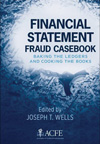 This book presents 33 case studies written by forensic accountants who have participated in financial-statement-fraud investigations. Each study begins with a readable description of main characters and the company or business involved, before explaining what was done to detect or unravel a particular fraud. Each study concludes with a set of "lessons learned" and recommendations for preventing fraud. The book is written for auditors and forensic accountants, with the goal of illustrating the types of financial fraud they may encounter, the kinds of questions they should ask, and the techniques they might employ when investigating a potential fraud. The editor hopes to prepare such professionals to "keep fighting the good fight" for accurate and reliable financial information, because "it does make a difference."
This book presents 33 case studies written by forensic accountants who have participated in financial-statement-fraud investigations. Each study begins with a readable description of main characters and the company or business involved, before explaining what was done to detect or unravel a particular fraud. Each study concludes with a set of "lessons learned" and recommendations for preventing fraud. The book is written for auditors and forensic accountants, with the goal of illustrating the types of financial fraud they may encounter, the kinds of questions they should ask, and the techniques they might employ when investigating a potential fraud. The editor hopes to prepare such professionals to "keep fighting the good fight" for accurate and reliable financial information, because "it does make a difference."
The preface contains a brief overview of financial frauds from the South Sea Bubble in 1711 to the passage of the Sarbanes-Oxley Act in 2002. It promises that the reader "will be exposed to the real world of financial statement frauds ... in all shapes and sizes – large, medium, small." It states that such frauds may "occur in nearly every corner of the globe."
The topics of the case studies range from owners of small businesses seeking bank loans to the financial reporting and deal-making of large public companies. Unfortunately, with the exception of the financial-statement fraud at Tyco International, "key names have been changed ... to protect privacy." As a result, it is not possible to identify the perpetrators of the frauds or the companies that were involved. Also, while the facts and techniques of the frauds described in the book differ, the lessons learned and recommendations for future action are often repetitive.
The editor correctly notes that financial-statement frauds "are almost always committed by those in ultimate charge of their organizations," and that they are nearly always intended "to conceal poor financial performance" from banks, shareholders, or other potential lenders or investors. A recurring theme is that auditors and accountants should exercise professional skepticism. They should be independent and diligent, be wary of clients who may try to control or limit their work, and understand that clients may try to exert pressure on them to overlook accounting treatments or deficiencies that may lead to exposing a financial statement fraud. These are lessons that may have some value for lawyers.
However, the book provides little information about the applicable rules that govern accounting, auditing, and internal accounting controls. Accordingly, the book overall appears to have only limited value for lawyers, apart from the insight that we too should exercise professional skepticism in dealing with clients, particularly if our work for those clients may relate to the preparation and use of financial statements.
Forensic Aspects of Driver Perception and Response, 3rd Edition
By Paul L. Olson, Robert Dewar & Eugene Farber (Tucson, AZ: Lawyers & Judges Publishing, 2010). 494 pgs. $99. Order, www.lawyersandjudges.com.
Reviewed by Farheen M. Ansari
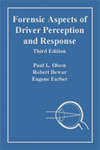 Forensic Aspects of Driver Perception and Response is an extremely dense book, full of technical terminology, charts, graphs, and even equations. It is definitely not an easy read. But if you are practicing any type of law involving accident reconstruction, operating-while-intoxicated violations, or driving in general, this is a great reference book that belongs in your library.
Forensic Aspects of Driver Perception and Response is an extremely dense book, full of technical terminology, charts, graphs, and even equations. It is definitely not an easy read. But if you are practicing any type of law involving accident reconstruction, operating-while-intoxicated violations, or driving in general, this is a great reference book that belongs in your library.
It is always a good idea to have some basic knowledge in areas for which you hire investigators and experts; reading in this book about issues related to your case will help you identify specific points on which to focus. Forensic Aspects is perfectly organized, like a textbook. It is divided into four major parts: "Factors Affecting Driver Perception," "Driving at Night," "Roadway Issues," and "Driver Issues." Within each part, a complete outline of every chapter is presented. Each chapter ends with a review, in which bulleted principal points are covered and references are listed. The book also contains an extensive index.
I would not suggest sitting down one weekend to read Forensic Aspects from beginning to end. Instead, I suggest that you use it whenever you have a case involving driving. You can easily look up and read about any issues relevant to your case, from human factors in accident reconstruction, to information processing for eyewitnesses, to relativity of objects, to problems with roadway signage, to just the (not so) plain old weather.
I appreciated that the authors included figures, tables, charts, and pictures throughout each chapter. With technical information of this nature, visual aids are necessary to understand and apply the science to real-life situations. The information in this book will be an immense asset in your analysis of every police and accident report you encounter.
Research Tax Credits
By Kreig D. Mitchell (Philadelphia, PA: ALI ABA, 2011). 296 pgs. $999. Order, www.ali-aba.org/BK88.
Reviewed by Cindy L. Hangartner
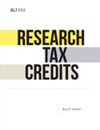 Kreig D. Mitchell, a former IRS attorney and appeals officer, has done a creditable job explaining the mechanics of calculating the research tax credit. According to the Government Accountability Office, research tax credits reduce costs to businesses engaging in new research by 6.4 to 7.3 percent. This is one of the largest business-tax incentives available to taxpayers.
Kreig D. Mitchell, a former IRS attorney and appeals officer, has done a creditable job explaining the mechanics of calculating the research tax credit. According to the Government Accountability Office, research tax credits reduce costs to businesses engaging in new research by 6.4 to 7.3 percent. This is one of the largest business-tax incentives available to taxpayers.
Complying with the procedures required to obtain the research tax credit may be cumbersome for taxpayers. The research tax credit comprises four distinct research credits. Research Tax Credits focuses solely on the regular research tax credit. The first 18 chapters begin with an overview and then move step by step through the process of determining a taxpayer's research tax credit. These chapters cover topics including 1) identifying the businesses to be included in the study, sources of information, research activities and business components, and qualified research; 2) identifying and excluding nonqualified research; and 3) defending research-tax-credit cases. The final chapter provides information on California's research tax credit.
Throughout the book, the author provides helpful guidance, including examples, charts, and diagrams. Appendices contain documents and information such as a survey questionnaire relating to employee job information, a refundable-research-tax-credit worksheet, a standard IRS information document request, a standard IRS audit report, IRS interview procedures, and an example of a wage qualified-research-expense list. A detailed table of contents, subject index, and table of authorities help readers who are trying to find discussion of particular aspects of the research tax credit.
With that said, Research Tax Credits will not likely appeal to a broad audience. The book targets tax advisors. Others who may find the book helpful include people conducting research-tax-credit studies, businesspeople contemplating new research, and some governmental employees.
Overall, Research Tax Credits is a well-organized guide for identifying business components and calculating the credit. One word of caution, however, is that poor editing becomes apparent as the book progresses. In some instances, incorrect words or non-words (such as "concisered") appear in the text. Most notably, there appears to be an error in the base calculation the author uses as an example. That error is carried through several additional calculations.
Commercial Vehicle Accident Reconstruction and Investigation, Second Edition
By Rick W. Varner & Roy F. Sutphen Sr. (Tucson, AZ: Lawyers and Judges Publishing, 2010). 442 pgs. $109. Order, www.lawyersandjudges.com.
Reviewed by John S. Swimmer
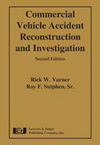 In Commercial Vehicle Accident Reconstruction and Investigation, coauthors Rick W. Varner and Roy Sutphen Sr. offer a comprehensive reference book geared toward accident investigators looking for techniques to help them assess a commercial vehicle accident scene. This text discusses in detail the unique aspects of commercial vehicle operation, performance, and regulations in the context of conducting an accident investigation. If you are interested in reconstructing truck accidents or if you are already involved in accident reconstruction, you may find useful the book's diagrams and brief explanation of most of the major systems of a commercial vehicle.
In Commercial Vehicle Accident Reconstruction and Investigation, coauthors Rick W. Varner and Roy Sutphen Sr. offer a comprehensive reference book geared toward accident investigators looking for techniques to help them assess a commercial vehicle accident scene. This text discusses in detail the unique aspects of commercial vehicle operation, performance, and regulations in the context of conducting an accident investigation. If you are interested in reconstructing truck accidents or if you are already involved in accident reconstruction, you may find useful the book's diagrams and brief explanation of most of the major systems of a commercial vehicle.
This is not a "how to" book on investigating a commercial accident scene. My criticism of this book is that it lacks some of the basic information about commercial vehicle accident investigation that I had hoped for when I started reading it. The book is geared toward veteran investigators. It has an excellent checklist and summary of the major systems of a commercial vehicle. My favorite parts of the book are the illustrations and diagrams that identify the various components of a semi-tractor and trailer. The diagrams, however, need to be updated. This book is probably not for most attorneys. It is a valuable reference book, but I found it lacking because of the absence of explanations of how to conduct accident investigations.
Find Info Like a Pro: Mining the Internet's Public Records for Investigative Research, Vol. 2
By Carole A. Levitt & Mark E. Rosch (Chicago, IL: ABA Law Practice Management Section, 2011). 367 pgs., w/CD-ROM. $79.95. Order, www.ababooks.org.
Reviewed by Nicholas Rudman
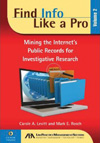 Internet investigative tools have vastly improved in quality and quantity in recent years. Nonetheless, most people begin a search by typing keywords into a search engine with little thought given to how to locate a website tailored to the information they really want and then, after generating a few unrelated "hits" or thousands of entirely irrelevant results, often abandon the search and turn to traditional discovery methods. In Find Info Like a Pro, the authors attempt to survey the expanse of Internet public records and provide the reader with search techniques that will save both time and money.
Internet investigative tools have vastly improved in quality and quantity in recent years. Nonetheless, most people begin a search by typing keywords into a search engine with little thought given to how to locate a website tailored to the information they really want and then, after generating a few unrelated "hits" or thousands of entirely irrelevant results, often abandon the search and turn to traditional discovery methods. In Find Info Like a Pro, the authors attempt to survey the expanse of Internet public records and provide the reader with search techniques that will save both time and money.
Although I read the book cover to cover, I don't recommend this approach to practicing attorneys. Accordingly, I also used the book for a few weeks in my own practice to test the authors' claims and found the book has some merit as a resource guide. At times, it may even achieve the authors' goals regarding time and costs. At other times, however, following the authors' suggestions took too long, and I found myself picking up the phone and calling state agency employees to ask them where to look.
For example, there are local companies that will conduct a simple asset search for approximately $165. Taking to heart the authors' claim that "this book will empower you," I conducted an online asset search using the book. Find Info Like a Pro first directed me to the local assessor's website for real property; nothing groundbreaking there. The authors also direct readers to their local register of deeds' website, pay sites that provide information on real estate records, and state department of motor vehicle sites. The book provided some helpful hints for searching for personal property, such as boats, airplanes, and intellectual property. In the end, however, it would have been more efficient and cost effective to hire an asset search firm for this particular task.
One very helpful component of the book is a CD-Rom containing a PDF document with 20 pages of hyperlinks to websites referred to in the hard-copy text. From Accurint (a public records pay site from LexisNexis) to Zillow (the real-estate site), the file contains hundreds of links. Although the links would be easier to navigate if organized by categories rather than alphabetically, the authors do an admirable job of distilling thousands of potential sites down to a manageable list. Noticeably absent among the many links to state and local dockets was a link to Wisconsin's Consolidated Court Automation Programs (CCAP).
This book might be helpful for attorneys looking to expand a collections or family law practice, as well as litigators conducting in-depth research on expert witnesses. Overall, however, the book spends significant time on topics that are either elementary or unnecessary, such as a discussion of "member-benefit" services like Fastcase and free case-law databases including Google Scholar. Thus, the book is probably best for the novice Internet researcher (of which there are likely fewer and fewer).
Wisconsin Lawyer
